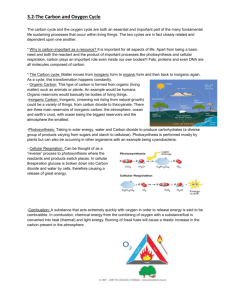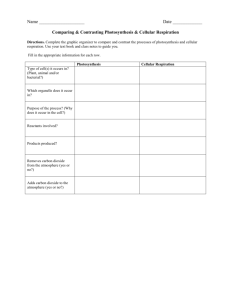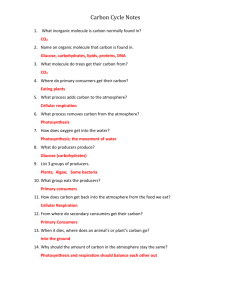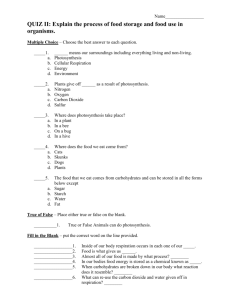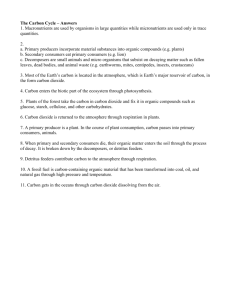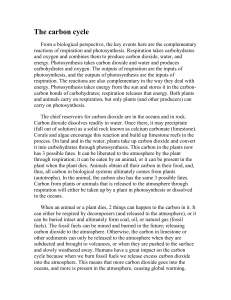The Carbon Cycle - Inner Space Cavern
advertisement
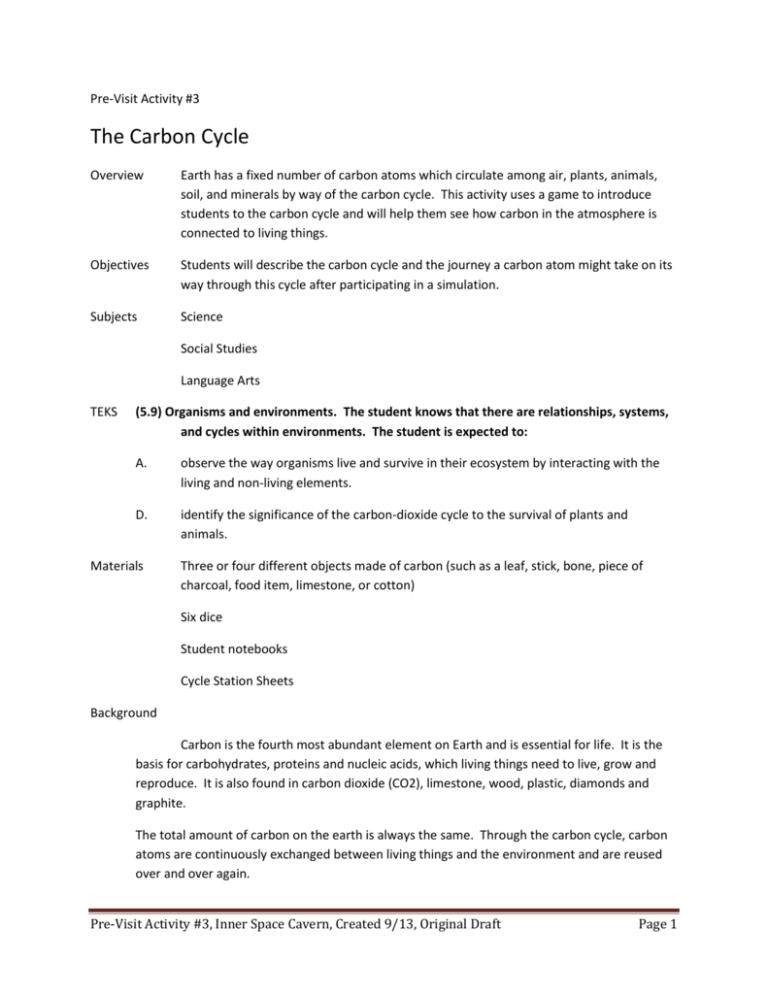
Pre-Visit Activity #3 The Carbon Cycle Overview Earth has a fixed number of carbon atoms which circulate among air, plants, animals, soil, and minerals by way of the carbon cycle. This activity uses a game to introduce students to the carbon cycle and will help them see how carbon in the atmosphere is connected to living things. Objectives Students will describe the carbon cycle and the journey a carbon atom might take on its way through this cycle after participating in a simulation. Subjects Science Social Studies Language Arts TEKS (5.9) Organisms and environments. The student knows that there are relationships, systems, and cycles within environments. The student is expected to: A. observe the way organisms live and survive in their ecosystem by interacting with the living and non-living elements. D. identify the significance of the carbon-dioxide cycle to the survival of plants and animals. Materials Three or four different objects made of carbon (such as a leaf, stick, bone, piece of charcoal, food item, limestone, or cotton) Six dice Student notebooks Cycle Station Sheets Background Carbon is the fourth most abundant element on Earth and is essential for life. It is the basis for carbohydrates, proteins and nucleic acids, which living things need to live, grow and reproduce. It is also found in carbon dioxide (CO2), limestone, wood, plastic, diamonds and graphite. The total amount of carbon on the earth is always the same. Through the carbon cycle, carbon atoms are continuously exchanged between living things and the environment and are reused over and over again. Pre-Visit Activity #3, Inner Space Cavern, Created 9/13, Original Draft Page 1 The basic carbon cycle of living systems (shown below) involves the processes of photosynthesis and respiration. Through photosynthesis, plants absorb carbon dioxide from the atmosphere and use it to make carbohydrates (sugars) with energy from the sun. As part of the cycle, animals eat plants (or other animals), taking in the carbohydrates for food. Then, through respiration, both plants and animals break down carbohydrates, releasing carbon dioxide into the atmosphere. This process can be described through the following formulas: Photosynthesis 6CO2 (carbon dioxide) + 6H2O (water) → C6H12O6 (glucose) + 6O2 (oxygen) Respiration C6H12O6 (glucose) + 6O2 (oxygen) →6CO2 (carbon dioxide) + 6H2O (water) Not all carbon atoms are constantly moving in the carbon cycle. As can be seen on “The Carbon Cycle” diagram, carbon may become stored in trees, wood products, fossil fuels or other carbon stores or “sinks.” Eventually, when the tree dies or if the products or fuels are burned, the carbon atoms will be released. They will then become an active part of the carbon cycle again. Forests play an important role in the global carbon cycle. They absorb carbon dioxide during photosynthesis, and store the carbon in their trunks, branches and roots. Both the trees and wood products can continue to store this carbon as long as they remain intact. Basic Carbon Cycle of Living Systems air (atmosphere) carbon dioxide carbon dioxide (respiration) (photosynthesis) animals plants carbohydrates (eating) Pre-Visit Activity #3, Inner Space Cavern, Created 9/13, Original Draft Page 2 Getting Ready Make one copy of each of the “Carbon Cycle Stations” student pages. On the board or using pen and paper, make a large label for each of the six stations: Air (Atmosphere), Tree, Firewood, Wood Product, Fallen Log, and Animal. Draw a basic carbon cycle on the board. Optional: Cut out and tape together the provided dice at the end of this activity. Doing the Activity 1. Show your students the objects you have brought in and ask what they all have in common. If the students do not think of it, point out that all of the items are made of carbon. Discuss carbon and why it is important. For example, ask: What is carbon? (Carbon is one of the most abundant elements on Earth, and is necessary for life.) Why do we need carbon? (Like all living things, we need carbon for the basic processes of life, including growth and reproduction.) How do living things get carbon? (There are two ways organisms can get the carbon they need. They either get it from the air-as plants do-or they get it by eating other living things. All of our food has carbon.) Beside food, how else do people use carbon? (We use carbon-based products like wood, cotton and wool, as well as plastics and other things made from petroleum. Fuels like gasoline and kerosene are also carbon-based.) If every living thing needs carbon, why isn’t it all used up? (Carbon gets reused over and over again in a process called the carbon cycle.) 2. Show students the basic carbon cycle you drew on the board. Explain how carbon dioxide (CO2) in the air becomes part of plants through photosynthesis, a process that turns the CO2 into food (carbohydrates). When animals eat plants or other animals, they ingest the carbon. Through respiration, carbon returns to the air as CO2. 3. Point out that in an ecosystem, like a forest, the process is more complex than this simple drawing. Show students “The Carbon Cycle” student page (or your drawing of it on the board) which describes the carbon cycle in a forest. Talk through the different parts of this cycle. 4. Point out that the carbon cycle is a simplified model for looking at the journey of a carbon atom. Explain that they will play a game to learn more about the forest carbon cycle. In this game, they will each be a carbon atom. Pre-Visit Activity #3, Inner Space Cavern, Created 9/13, Original Draft Page 3 5. Divide the class among the different stations to begin. Place the station cards in different location around the room, and place one die (if using) at each station. 6. Have each student roll the die or chose a number between one and six, and then read the statement at their station corresponding to that number. They should write in their notebooks the current station, what happens to them based on their number, and where they will go next. Sample notebook entry: Station Tree What Happens? The tree is hit by a storm, falls over and dies. Where to Next? Dead matter 7. When you call out “cycle,” students should go to the next station as directed on the card. If the directions have them stay at the same station, the student will take another turn at that station. 8. Repeat steps 6 and 7 ten more times or until most students have cycled through the Tree Station at least once. 9. Discuss the following: At which station did you spend the most time? At which station did you spend the least amount of time? While each of your journeys was different, was there anything similar about them? At which stations can carbon be stored? At which stations is carbon released into the atmosphere? What are the different paths carbon might take after becoming a tree? Which paths release carbon quickly into the atmosphere, and which store carbon for a long period of time? Assessment Ask students to write a brief story from a carbon atom’s point of view that describes the journey they just took through the carbon cycle. For example, a student might start a story, “I was a carbon atom in a tall tree. One day a fierce storm came, and knocked the tree over. It lay for a long time on the forest floor. As it decayed, I was released into the atmosphere…” Pre-Visit Activity #3, Inner Space Cavern, Created 9/13, Original Draft Page 4 The Carbon Cycle 3 5 6 2 4 1 3 5 6 2 4 1 These can be used in place of dice. The blank boxes are to help with construction, and go on the inside of each die. The tab with the 3 should be folded last and taped in place. 3 5 6 2 4 1 3 5 6 2 4 1 3 5 6 2 4 1 3 5 6 2 4 1

